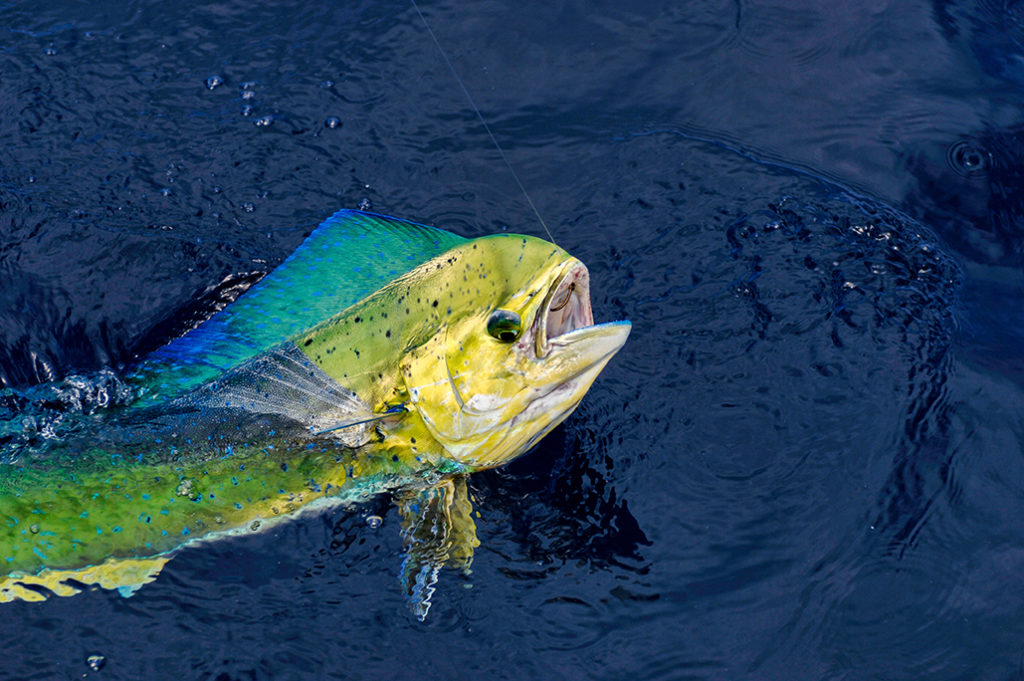
Mahi-Mahi is not only an amazing fish to eat, it’s exciting to catch. Also known as the dolphinfish, Mahi-Mahi are one of the most impressive fish to have on your line.
Mahi-Mahi Fishing Season in Myrtle Beach
Dolphin (Mahi Mahi) fishing in Myrtle Beach varies throughout the year.
- High-Season: May through August
- Low-Season: Jan through March & November Through December
- Closed-Season: None
About Mahi-Mahi (Dolphinfish)
Mahi-Mahi are a large species of fish with a single, large dorsal fin from its head to its tail. Males’ can easily be distinguishable by their rounded head and protruded out. Females’ heads are round and smooth. The Mahi-Mahi is an extremely vibrant & brightly colored fish that can range from golden to brightly colored blue and green on its side. On average Mahi-Mahi grow to be around 2.5′ to 4.5′ long and catches have been recorded from 15 pounds to over 40 pounds!
The Rabbits of the Ocean
Mahi-Mahi are known as “the rabbits of the ocean”as they can reach maturity at 4-5 months and are fully mature by the time they are a year old.
Female Mahi-Mahi can lay 100,000 to 1,000,000 eggs at a time which happens two to three times per year.
Mahi-Mahi are migratory fish who typically swim north as the waters worm. In Myrtle Beach, Mahi are most often found in the Gulf Stream which is typically around 60+ miles from shore.
Dolphin fish reproduce at a rapid rate. They are sometimes jokingly referred to as “the rabbits of the ocean” Dolphin fish reach maturity at 4-5 months old, and should definitely be fully mature by the time they’re a year old.
10 Fun Mahi Fishing Facts
- The dolphin fish is a very fast swimmer, reaching speeds of up to 60 mph.
- The name “mahi-mahi” literally means “strong strong” in Polynesian. The name originates from Hawaii, where the fish are prevalent
- The fish is also called “dorado” in Spanish, a name that stems from its golden color.
- Dolphin fish lose their golden hues once they leave the water, and eventually turn a silvery color
- Dolphin fish eat crab, squid and other crustaceans, as well as on other fish, like mackerel.
- Outside of the Caribbean, the United States is the largest consumer of dolphin fish
- Dolphin fish do not raise their young. Once the eggs hatch, the young dolphinfish quickly band together in schools to help ensure survival.
- The young fish, and smaller dolphin fish, travel in schools of anywhere from a handful of fish to up to fifty fish. Larger fish travel alone, or sometimes in pairs.
- The main predators of dolphin fish are sharks, swordfish, marlins, birds, and of course, humans.
- Dolphin fish are very strong, and are known for being difficult to catch on fishing lines.
Mahi-Mahi Myrtle Beach Fishing Report
The Mahi-Mahi are now biting frequently in the Gulf Stream. “Playing Hooky” a 26′ Sea Pro 259 DLX from Saltwater Pros has recorded regular catches 65 miles out from North Myrtle Beach in the Gulf Stream in around 250 feet of water along weed lines and 75 degree to 79 degree temp changes.